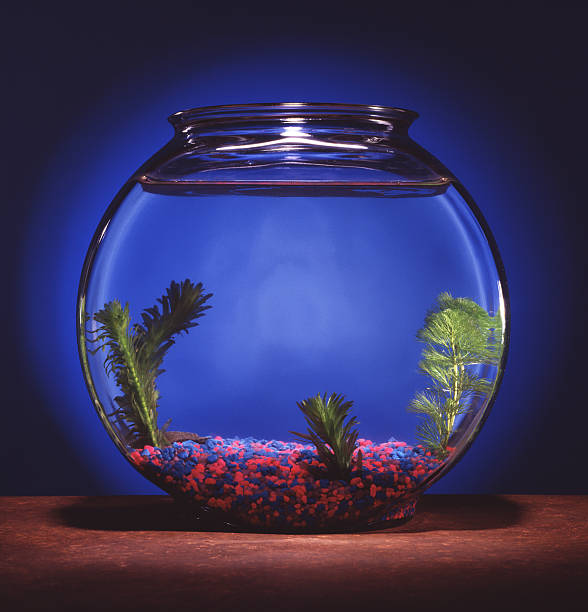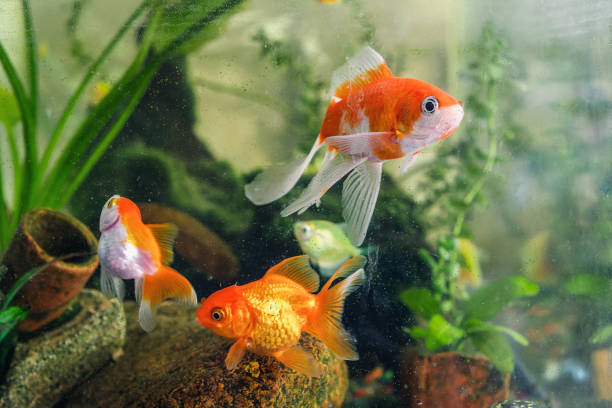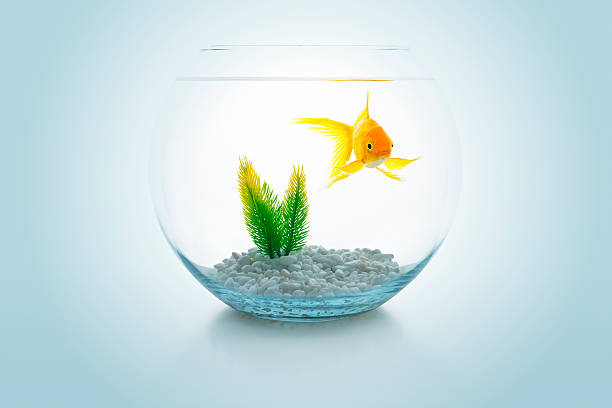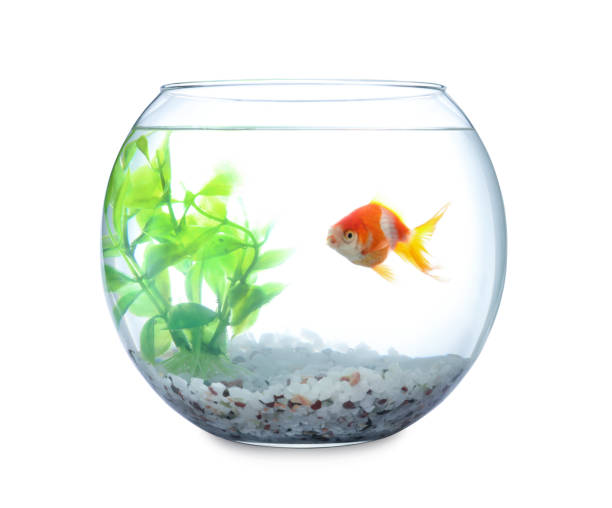Introduction to Planted Tanks for Goldfish
Creating a harmonious environment for goldfish and plants can be both rewarding and challenging. Many goldfish keepers wonder if it’s possible to maintain a thriving planted tank. The answer is a resounding yes! However, it requires careful planning and selection of both goldfish and plants to ensure compatibility.
Known for their energetic behavior and constant foraging, these fish can be rough on delicate plants. Yet, with the right combination of hardy plants and proper tank setup, goldfish and plants can coexist beautifully. Understanding the dynamics between goldfish and plants is critical to achieving a balanced aquarium ecosystem. Planted tanks for goldfish enhance the aesthetic appeal while contributing to the tank’s overall health. Plants help maintain water quality by absorbing nitrates and producing oxygen, creating a natural filtration system that benefits goldfish and fosters a clean, healthy environment.
Choosing the right plants is essential for a successful goldfish tank. Opt for robust species that can withstand the nibbling and digging habits of goldfish. Common choices include Crinum calamistratum, Anubias, Java Fern, and Marimo Moss Ball, known for their resilience and minimal maintenance requirements. Proper lighting and substrate are also crucial factors to consider. Goldfish and plants each have specific needs; finding a balance ensures both thrive. Using a suitable substrate that anchors plants securely while allowing goldfish to dig can reduce plant displacement and damage.
In conclusion, a planted tank for goldfish is achievable with the right approach. Careful plant selection and thoughtful tank design result in a vibrant, healthy aquarium where goldfish and plants flourish together. Stay tuned as we dive deeper into the specifics of creating an ideal planted tank for goldfish in the following sections.
Expectations of Planted Tanks for Goldfish
Goldfish and plants can co-exist harmoniously in a well-maintained aquarium. However, understanding the expectations of planted tanks for goldfish is crucial for success. Goldfish are notorious for being messy, and their tendencies can affect plant health.
First, consider that goldfish produce a considerable amount of waste. This waste generates nitrates, which can benefit plant growth if managed properly. High nitrate levels, however, can lead to algae issues, so balance is key. Goldfish are also known for their digging behavior, often uprooting delicate plants, making sturdy and well-anchored plants preferable. Select plants with robust root systems or those that can attach to decorations like driftwood or rocks.
Water parameters are another important factor. Goldfish thrive in cooler water temperatures, which means selecting plants that can tolerate similar conditions is important. Ensure that the water pH and hardness levels suit both the fish and the plants.
Lighting should also be adjusted to meet the needs of both goldfish and plants. While goldfish do not have specific lighting needs, plants require the right intensity and duration of light to photosynthesize effectively. Consider using aquarium lights designed for planted tanks to achieve optimal plant growth.
Expect some trial and error when introducing plants into a goldfish tank. Observe how your goldfish interact with the plants and make adjustments as needed. Over time, you’ll find the right mix that meets the needs of both your goldfish and plants.
By managing these expectations, you can create a thriving and aesthetically pleasing planted tank for goldfish. This symbiotic environment enhances the beauty of your aquarium and contributes to the well-being of your goldfish.

When to Add Plants to Your Goldfish Tank
Adding plants to your goldfish tank can provide numerous benefits, but it’s important to know the right time to introduce them. Goldfish and plants can coexist harmoniously if the timing of plant introduction is carefully managed.
When setting up a new goldfish tank, allow the aquarium to complete its initial nitrogen cycle before adding plants. This usually takes about 4–6 weeks. The cycling process allows beneficial bacteria to establish, which helps maintain water quality, crucial for the health of both your goldfish and plants.
Adding plants to a well-established tank can be done at any time, but it’s always better to introduce them after a water change when the environment is cleaner and less stressful. Before adding plants, ensure your goldfish are healthy and free from any diseases, as introducing new elements to a compromised environment can aggravate health issues.
When introducing plants, start with hardy species such as Anubias, Java Fern, or Crinum Calamistratum. These plants are more likely to withstand the initial rooting period without suffering damage from curious goldfish. Gradually acclimate your goldfish to the presence of these plants by keeping replacements on hand, as goldfish often nibble on new additions out of curiosity or hunger.
Monitoring water parameters during this period is essential. Plants help absorb nitrates, improving water quality, but it’s crucial to check for significant changes that might affect your goldfish. Ensure the tank is well-lit and that plants have access to essential nutrients, possibly through the use of specialized liquid fertilizers.
In summary, for a harmonious goldfish and plants setup, patience and careful monitoring are key. Introduce plants after the nitrogen cycle is complete or during routine water changes to create a balanced and healthy aquatic environment.
Choosing the Right Plants: Stems, Bunches, or Potted
Selecting the right plants for your goldfish tank is essential for both aesthetic and practical reasons. Goldfish and plants can coexist harmoniously if you make informed decisions from the outset. Whether you opt for stems, bunches, or potted plants, each has unique benefits and challenges.
Stem Plants
Stem plants are a popular choice for goldfish tanks due to their fast growth and ability to absorb excess nutrients. Plants like Elodea and Hornwort are excellent options. They can be planted directly into the substrate or left to float. Floating stem plants provide shade and reduce algae growth. However, goldfish might nibble on these delicate plants, so periodic replacement may be necessary.
Bunch Plants
Bunch plants typically come in groups and can be tied together with plant weights or wrapped around decorations like bogwood. Species such as Anubias and Java Fern are robust and less likely to be uprooted by goldfish. These plants don’t require deep substrate planting, making them suitable for tanks with gravel or sand.
Potted Plants
Potted plants offer a stable option for goldfish tanks. These come in small pots filled with specialized substrate, which makes them less likely to be disturbed by goldfish activities. Plants like Crinum Calamistratum and Bolbitis Fern are ideal for potted setups. The pots can be hidden within the tank layout, adding to the tank’s natural appearance while providing a secure home for your plants.

Selecting the Best Substrate for Plant Growth
Choosing the right substrate is crucial for the health and growth of both goldfish and plants in your tank. The substrate acts as the foundation, providing nutrients and stability for plant roots. Goldfish and plants have different needs when it comes to substrate, so finding a balance is key. Goldfish produce a lot of waste, which can break down and act as a natural fertilizer for plants.
However, the substrate must be carefully selected to ensure it doesn’t harm the goldfish or impede water quality. Gravel is a popular choice for goldfish tanks due to its ease of cleaning and ability to anchor plants. Fine gravel or sand can be an excellent fit as it allows plant roots to spread easily while still being safe for goldfish.
Some aquarists prefer to use specialized aquatic plant substrates that are rich in nutrients. These substrates can provide a boost to plant growth, but they may require more maintenance to keep clean. Mixing a nutrient-rich substrate with a top layer of gravel is a practical solution to balance the needs of goldfish and plants. Avoid substrates with sharp edges that could injure your goldfish. Using larger pebbles can help prevent goldfish from digging up plants, keeping both the plants and fish happy.
In conclusion, selecting the best substrate for plant growth in a goldfish tank involves considering both the nutritional needs of the plants and the health of the goldfish. Aim for a balanced approach that keeps your aquatic environment clean, healthy, and conducive to robust plant growth.

Top 10 Plants for Goldfish Tanks
Selecting the best plants for goldfish tanks is crucial to creating a balanced and healthy aquatic environment. Goldfish and plants can coexist harmoniously if you choose species that are robust and can withstand the activity and nibbling of goldfish. Here are the top 10 plants that are highly recommended for goldfish tanks.
1. Anubias
Anubias is a popular choice among goldfish keepers. Its thick, sturdy leaves can withstand nibbling and its rhizome can be attached to rocks or bogwood, making it less likely to be uprooted by curious goldfish.
2. Java Fern
Java Fern is another excellent option for goldfish tanks. This plant grows well in low light and can be attached to decorations using fishing line or plant glue, preventing the goldfish from pulling it up.
3. Marimo Moss Ball
Marimo Moss Balls are not only fascinating to observe but are also highly durable.
Goldfish enjoy playing with these balls, and they help in absorbing excess nitrates in the water.
4. Crinum Calamistratum
Crinum Calamistratum features long, wavy leaves that are difficult for goldfish to destroy. This plant can adapt to a wide range of water conditions, making it a resilient choice for a goldfish tank.
5. Bolbitis Fern
Bolbitis Fern, also known as African Water Fern, has tough leaves that are not easily eaten by goldfish. It grows best when attached to rocks or driftwood, adding a natural look to your aquarium.
6. Hornwort
Hornwort is a floating plant that can be anchored down if needed. It grows rapidly, providing plenty of hiding spots and nibbling areas for goldfish, and it’s efficient at absorbing excess nutrients.
7. Elodea
Elodea is a fast-growing plant that can tolerate the digging behavior of goldfish. It helps keep the water clean by consuming nitrates and providing oxygenation.
8. Vallisneria
Vallisneria, or eelgrass, is perfect for goldfish tanks due to its tall, ribbon-like leaves. It grows quickly and can withstand goldfish nibbling and uprooting attempts.
9. Water Sprite
Water Sprite can grow submerged or as a floating plant. Its delicate leaves might be nibbled on, but its rapid growth ensures it remains a healthy addition to your tank.
10. Anacharis
Anacharis is a versatile plant that thrives in various conditions. It floats or can be planted in the substrate, providing excellent cover and reducing algae growth by competing for nutrients.
Conclusion
Choosing the right plants can transform your goldfish tank into a vibrant, natural aquatic habitat. By selecting robust plants such as Anubias, Java Fern, and Crinum Calamistratum, you can ensure a harmonious coexistence between goldfish and plants. These top 10 plants not only enhance the visual appeal of your tank but also contribute to its overall health and balance.

How to Plant and Maintain Aquarium Plants
Planting and maintaining aquarium plants in a goldfish tank can greatly enhance the aesthetic and ecological balance of your aquatic environment. Goldfish and plants can coexist harmoniously, provided the right care practices are followed. First, choose robust and resilient plants that can withstand the goldfish’s activity. Plants like Anubias and Java Fern are excellent choices as they have sturdy leaves that goldfish are less likely to destroy. These plants also attach easily to decorations like bogwood or rocks.
When planting, ensure you secure the plants well. Goldfish tend to dig into the substrate, which can uproot fragile plants. Using terracotta pots or attaching plants to larger rocks can help keep them in place. For plants with delicate roots, using a fine gravel or plant-specific substrate will encourage healthy root growth. To maintain your aquarium plants, regular pruning is essential. Goldfish produce a significant amount of waste, which can lead to algae growth. Trim any dead or decaying leaves to prevent algae and keep your tank looking clean.
Lighting is another crucial factor in maintaining aquatic plants. Ensure your goldfish tank has adequate lighting, typically 8-10 hours a day, to support photosynthesis. However, avoid excessive light, as it can promote unwanted algae growth. Fertilization is often necessary to provide essential nutrients for plant growth. Use aquarium-safe fertilizers that do not harm goldfish. Liquid fertilizers and root tabs can supply vital nutrients like nitrogen and potassium, which are often depleted in a goldfish tank.
Regular water changes are vital for both goldfish and plants. Goldfish produce high levels of waste, which can lead to elevated nitrate levels. Performing 20-30% water changes weekly will help maintain water parameters conducive to plant growth. Lastly, monitor your plants and goldfish regularly. Check for signs of plant decay or nutrient deficiencies. Observing your goldfish for unusual behavior can also indicate problems with water quality or plant health.
By following these guidelines, you can successfully plant and maintain aquarium plants in your goldfish tank, creating a lush and balanced aquatic habitat.

Creating an Aesthetic Layout
Creating an aesthetic layout in your goldfish tank can enhance the visual appeal while promoting the well-being of your fish and plants. Integrating goldfish and plants harmoniously requires careful planning and consideration of various elements. Start by selecting a variety of plants that can coexist with goldfish. Plants with robust leaves and strong roots, like Java Fern, Anubias, and Crinum Calamistratum, are ideal choices. These plants are resilient and can withstand the curious and sometimes nibbling nature of goldfish.
Consider the placement of these plants strategically. Foreground plants should be smaller and low-growing, while background plants should be taller to create a sense of depth. Midground plants can act as transitional elements, blending both areas seamlessly. Using different plant species helps to provide a layered look and mimics a natural habitat for your goldfish and plants. Arrange rocks, driftwood, and other aquarium decorations thoughtfully. These elements not only contribute to the tank’s aesthetics but also offer hiding spots and territories for goldfish. Ensure that these decorations do not obstruct the lighting or water flow essential for plant growth.
Lighting plays a crucial role in maintaining the health of both goldfish and plants. Opt for a balanced light spectrum that supports plant photosynthesis and enhances the colors of your fish. LED lights are an excellent choice as they are energy-efficient and customizable. Experiment with different layouts and plant combinations to find what works best for your setup. Observe how goldfish interact with the plants and adjust accordingly. Remember, creating a stunning and functional aquarium may take some trial and error, but the effort is well worth it.
Lighting Requirements for Planted Goldfish Tanks
Understanding the lighting requirements for a planted goldfish tank is essential for healthy growth of both goldfish and plants. Adequate lighting provides energy for photosynthesis, which is vital for the plants to thrive. Goldfish and plants have different needs, so achieving a balance is key.
Goldfish tanks typically need a medium light intensity. Too much light can lead to excessive algae growth, turning your tank green and unhealthy. Conversely, too little light can stunt plant growth and result in unhealthy foliage. Plants like Java Fern, Anubias, and Marimo Moss Ball thrive well under low to medium light conditions, making them ideal for goldfish tanks. Using LED aquarium lights can offer a tailored spectrum suitable for both goldfish and plants. Regular monitoring of light intensity and duration can help ensure the equilibrium between goldfish health and plant growth.
This way, your goldfish and plants can coexist harmoniously, creating a visually appealing and ecologically balanced tank. Maintenance Tips for a Healthy Planted Tank Maintaining a healthy environment for goldfish and plants can be both rewarding and challenging. Regular upkeep is crucial to ensure your goldfish and plants thrive together.
First, monitor the water quality frequently. Goldfish produce a significant amount of waste, which can alter water parameters. Regularly check for ammonia, nitrate, and pH levels, ensuring they remain within optimal ranges for both goldfish and plants. Next, perform weekly water changes. This practice helps in removing excess waste and replenishing essential nutrients for the plants. Aim for a 20-30% water change to keep the tank environment stable.
Algae control is another critical aspect. Goldfish and plants can suffer from algae overgrowth if not managed properly. Introduce algae eaters like snails or certain shrimp species, and regulate lighting to prevent excessive algae. Trim and prune the plants regularly. Overgrown plants can overshadow others, blocking light and hindering growth. Remove dead or decaying leaves to prevent the build-up of organic waste, which goldfish might nibble on.
Check the substrate periodically. Unwanted debris can accumulate in the gravel, affecting the health of both goldfish and plants. Use a gravel vacuum to clean the substrate, ensuring roots are not disturbed. It’s essential to feed your goldfish properly. Overfeeding can lead to uneaten food sinking and rotting, which can be detrimental to water quality. A well-fed goldfish is less likely to nibble on the plants excessively.
By following these maintenance tips, you can create a thriving habitat for your goldfish and plants. A balanced, well-maintained tank will not only look beautiful but also provide a healthier environment for your aquatic pets.

Common Challenges: Will Goldfish Eat My Plants?
One of the biggest concerns for aquarists is whether goldfish will eat their plants. When setting up a tank with goldfish and plants, it’s crucial to consider this potential challenge. Goldfish are known for their tendency to nibble on plants, a behavior that can devastate delicate aquatic flora. Goldfish and plants can coexist, but it requires careful planning and plant selection. Goldfish are omnivores, and they naturally graze on plant material. This means they may treat certain plants as a food source rather than just decoration.
To mitigate this issue, it’s essential to choose robust and hardy plants. Species like Anubias, Java Fern, and Marimo Moss Balls are known to withstand the nibbling habits of goldfish. These plants have tougher leaves and rhizomes that are less palatable to goldfish. Additionally, you can strategically place the plants in the tank. Using rocks or terracotta pots to anchor the plants can help protect the roots from being uprooted by the goldfish. This can prevent the goldfish from disturbing the substrate and damaging the plants’ root systems.
Another strategy is to provide plenty of plant material for the goldfish to munch on, reducing their focus on the live plants. Floating plants such as Duckweed and Hornwort can act as a supplemental food source, giving your goldfish something to nibble on without destroying your main plants. In summary, while goldfish may nibble on plants, selecting the right species and employing strategic planting methods can create a harmonious tank environment. Goldfish and plants can coexist beautifully, adding both aesthetic and biological benefits to your aquarium. By understanding your goldfish’s behavior and planning accordingly, you can maintain a thriving, planted goldfish tank.

Alternatives: Using Fake Plants
When it comes to maintaining a goldfish aquarium, one common concern is whether the goldfish will damage or eat the plants. Using fake plants is a viable alternative that addresses this issue effectively while still achieving an aesthetic layout. Fake plants in a goldfish tank offer several advantages. Firstly, they are immune to the nibbling habits of goldfish, ensuring that your tank’s decor remains intact. Secondly, fake plants do not require the same maintenance as live plants, making them a convenient option for busy goldfish keepers.
Plastic plants and silk plants are popular choices for aquariums. Plastic plants are durable and come in various shapes and sizes to suit different tank layouts. Silk plants, on the other hand, provide a more natural appearance and move gently with the water current, mimicking the movement of real plants. Another benefit of using fake plants is that they do not affect the water quality in your goldfish tank. Unlike live plants, fake plants won’t contribute to the tank’s bioload or produce waste. This can help in maintaining a stable aquatic environment for your goldfish.
Moreover, fake plants can be easily cleaned and repositioned, allowing for flexibility in tank decor. When choosing fake plants for your goldfish tank, ensure that they are aquarium-safe and free from any harmful chemicals. Cheaper plastic plants may sometimes leach harmful substances into the water, which could affect your goldfish’s health. While fake plants do not contribute to the biological filtration system as real plants do, they can still provide hiding spots and reduce stress for goldfish. This contributes to an overall healthier and more comfortable environment for your fish.
In conclusion, using fake plants in a goldfish tank is a practical and visually appealing alternative. It alleviates concerns about goldfish eating or damaging live plants and simplifies tank maintenance. For goldfish keepers looking for low-maintenance options, fake plants offer a robust solution that keeps your tank looking vibrant and beautiful.

Conclusion: Achieving a Balanced Goldfish Tank
Achieving a balanced goldfish tank with plants is fully achievable with the right approach. When incorporating both goldfish and plants, it’s essential to select robust and suitable plant species that can withstand the activity of goldfish. Goldfish tend to nibble on plants, so choosing hardy varieties like Anubias or Java Fern ensures that your tank remains lush and green.
Maintaining an appropriate substrate and providing adequate lighting are key to a thriving aquarium. Using fertilizers specific to aquarium plants can further support plant growth and enhance their overall health. Regular maintenance and monitoring of water conditions prevent issues such as algae growth or nutrient imbalances. Arrange the plants to allow goldfish plenty of swimming space, making the tank not just a botanical garden but also a comfortable home for your fish.
In conclusion, the harmonious combination of goldfish and plants enhances the aesthetic appeal of your tank while contributing to a healthier aquatic environment. Achieving this balance requires careful planning, consistent maintenance, and a solid understanding of the needs of both goldfish and plants. By following these guidelines, your goldfish at The Goldfish Tank can thrive beautifully, providing a wonderful experience for both you and your goldfish.
